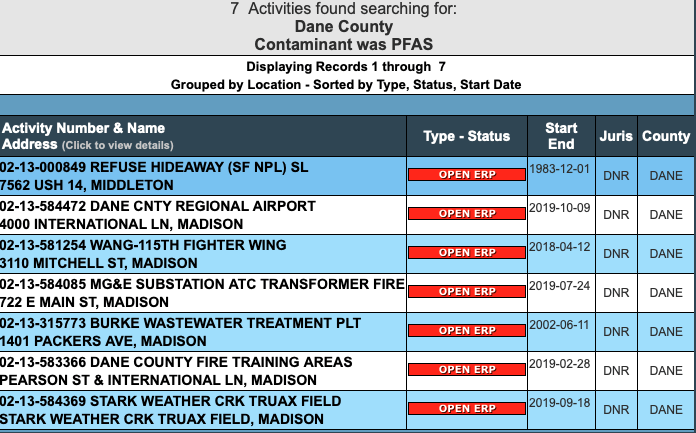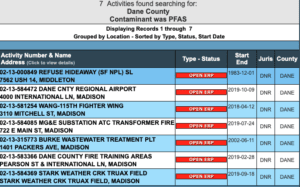Here’s what the County Attorney had to say to the Lakes and Watershed Commission last Thursday. They have complied with all the DNR requests. But can they do more?
Here’s the brief video.
Here’s what she had to say.
Amy Tutwiler from Dane County Corporation Council’s Office is an Assistant Corporation Counsel. She works here in the Dane County offices, her background includes environmental law, a master’s degree in environmental studies from Madison. She has experience handling contaminated sites and it’s that’s how she got involved in this particular project. Tonight she wants to give you some background about what’s happening at the airport, it’s the start of information and we are going to continue to find ways to engage the public.
DNR Notifications Starkweather Creek and Stormwater runoff. At this point I can tell you that in October 2019 the DNR notified 3 parties they believe are responsible for the contamination and Starkweather Creek. Those parties are Dane County, the City of Madison and the Air National Guard. Also in October 2019 DNR notified Dane County that about PFAS levels detected in the Dane County Airport stormwater system. So right now the suspected source of PFAS contamination in the area of the airport is the AFFF firefighting foam that Doug mentioned. The Dane County Airport, you should know, contracts with the Air National Guard for its fire fighting services. Therefore at this point in time the county has no reason to believe that county employees have handled that AFFF foam.
FAA requires PFAS firefighting foam. Some background that’s helpful to know that the Federal Aviation Administration, commonly known as the FAA, actually requires the airport to use fire fighting services to use the AFFF foam in emergencies and for training. The reason is because it works it’s excellent at putting out fires and at this point it’s the best way to save lives. That said the FAA has set a three year deadline for the federal government to come up with a replacement for PFAS foam. In other words of where they’re moving toward a firefighting foam that would be PFAS-free. Right now we’re currently in year two of that three-year deadline.
No more training firefighting training at Truax. Historically the firefighting training occurred at the Truax Air National Guard base at the original airport. At this point in time the Air National Guard has advised the county that it’s no longer conducting training at the Truax field and has moved those training activities to the Volk Field in Juneau County. Thus at this point in time the only discharge of firefighting AFFF firefighting foam we would expect at the airport would be in the event of an emergency, basically a fire.
Compliance with DNR directives. DNR directives in the October set deadlines for the county and other responsible parties to take certain specific actions to proceed with the investigation of where the PFAS in Starkweather Creek is coming from. Dane County has met all of its deadlines. At this stage of the process the county has hired a consultant which is Mead and Hunt. You should understand they have a very in-depth knowledge of the county stormwater system, they also are following the PFAS developments at the national level. In terms of what our deliverables are for the DNR we were required, in December, to submit a work plan for our next steps.
County plan. The plan that Mead and Hunt submitted on behalf of Dane County includes further sampling of the airport stormwater system. The goal of which is to determine what the source of discharge coming into the stormwater system is and then additional investigation into the historic airport operations that would be relevant to PFAS use. So we can do our best, a remediation process always wisely has to start with an investigation. Knowing that we have it in a creek is step one. Step two is to answer where is it coming from and how did it get there basically. With that goal in mind, you’re gonna look for where the amounts are highest, basically it’s a system of prioritizing. Since the consultants have submitted that report, as I mentioned it was in December, we now have this new sampling results from DNR in Starkweather Creek which came out in January (January 15). So the county’s consultant is now in the process of revising the work plan and to factor in this new information the new data into their investigation process. What I can tell you, I’m sure frustrating to hear, but the process of an investigation has to occur in steps. So what will happen is at each step of the sampling the consultants will be able to further define where the PFAS is located and ultimately the goal is to identify where in the ground it is coming from. In other words what’s the source. Understanding that the what where the PFAS originates the property is going to be an essential part to to making wise decisions about how to remediate it going forward.
Other actions. The county has been working with the other responsible parties to install and update the signage and provide fish advisories and then letters to impacted residents.
Website for airport investigation process. We are in the process of developing a webpage for the airport investigation process. That will likely be linked to the public health website. That’s in process.
Public information meetings. Also we now that we’ve we’ve got the planning underway once we have the updated sampling plan then at that point we’ll schedule a public informational meeting to give you an update on what’s happening. I expect that the webpage will ultimately include all the reports that are submitted to the DNR.
Supervisor and Chair Chuck Erickson asks when that public meeting will be?
She estimates mid-March. What has to happen is the consultants have to submit the plan and then DNR has to approve it. Then once we have it in my experience that happens is a little refining has to happen and then once we have it.
Erickson confirms March 2020.
She agrees. Erickson says that there will be notifications about that and people can come to that meeting.
Supervisor Heidi Wegleitner asks if the reports submitted to the DNR are a public record? How can people see them if they are not available on this website yet?
Tetwiler says the reports are publicly available through the DNR webiste, the BRRTS site. the reports the county submitted will be there. An audience member asks what the name is, because you have to type in something to find the information. A commissioner suggests that they just look it up by PFAS and it will be there. Tetwiler says there will be three BRRTS sites. The Air National Guard has a BRRT site, the Starkweather Creek has a BRRT site, that is the one that includes the County, City and Air National Guard. The third will be the Dane County Stormwater system.
No time for questions, they move on quickly to get to public testimony.
MORE ON BRRTS
BRRTS is the Bureau for Remediation and Redevelopment Tracking System. Its a DNR on-line database with information about contaminated properties and activities related to investigation and clean up of contaminate soil or groundwater.
Well, here’s what I was able to find by clicking on “open BOTW” and I did an “advanced search” and typed in PFAS in the “substance” and “Dane” in the county. And here you can find 7 open activities.
I found 4 sites.
- 02-13-584472 DANE CNTY REGIONAL AIRPORT
- 02-13-581254 WANG-115TH FIGHTER WING
- 02-13-583366 DANE COUNTY FIRE TRAINING AREAS
- 02-13-584369 STARK WEATHER CRK TRUAX FIELD
And there is sill this one too.
Here are some key documents you may be interested – thanks to Maria Powell for pointing them out for me!
- June 18, 2018 DNR letter to city, county, and airport re burn pit contamination:https://dnr.wi.gov/botw/DownloadBlobFile.do?docSeqNo=127737&docName=20190618_99_Contamination_Ltr_Darwin_Rd.pdf
- July 31, 2018 Truax ANG letter signed by city and county saying they will take over the burn pit investigations:https://mejo.us/wp-content/uploads/2019/01/2018.7.31.115-FW-response-to-WIDNR-Fire-Training-Areas-2018.pdf
- October 7, 2019 Report with airport PFAS data: https://dnr.wi.gov/botw/DownloadBlobFile.do?docSeqNo=132340&docName=20191007_43_Status_Rpt.pdf
- October 7, 2019 DNR RP letter to city, county, and Truax: https://mejo.us/wp-content/
uploads/2019/11/2019.10.7.- DNR-Burn-Pit-RP-letter-with- attachments.pdf - October 9, 2019 Notification of Hazardous Discharge: https://dnr.wi.gov/botw/DownloadBlobFile.do?docSeqNo=135074&docName=20191009_1_Notification.pdf
- October 11, 2019 DNR Responsible party letter just to airport: https://dnr.wi.gov/botw/DownloadBlobFile.do?docSeqNo=132418&docName=20191011_2_RP_Ltr.pdf
- October 29, 2019 PHMDC draft letter to residents/signs for creek, includes table with three rounds of Starkweather PFAS data: https://dnr.wi.gov/botw/DownloadBlobFile.do?docSeqNo=135078&docName=20191029_43_Results_Surface_Water_Testing.pdf
- November 21, 2019 Airport consultant letter to Schmoller: https://dnr.wi.gov/botw/DownloadBlobFile.do?docSeqNo=138771&docName=20191121_99_Status_Response.pdf
- December 6, 2019: Airport consultant proposed investigation plan: https://dnr.wi.gov/botw/DownloadBlobFile.do?docSeqNo=140603&docName=20191206_35_SIWP.pdf
FULL MEETING
Here’s the full meeting if you want to see the public comments, public health presentation (also blogged about) and commission discussion on a few other items. This contains suggestions from the public about what needs to be done.






